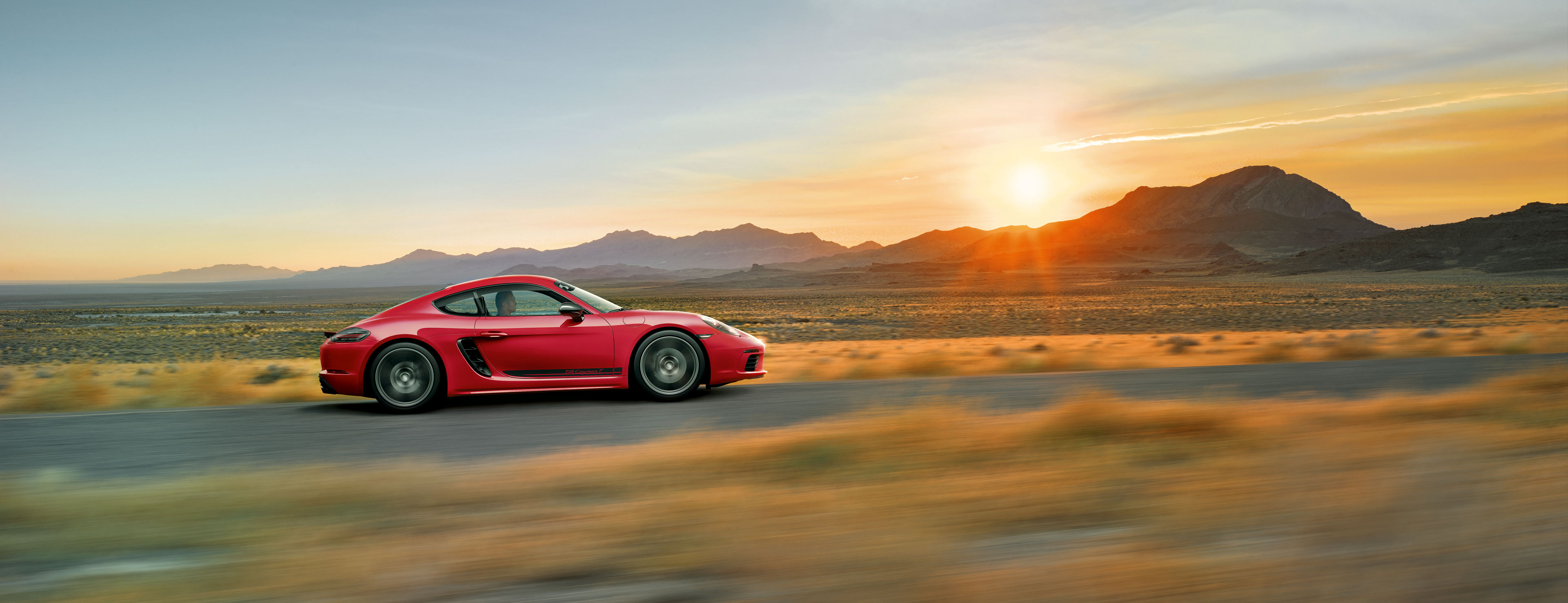
Purism & Performance
T-typical: Twenty-inch rims in titanium gray, agate-gray mirror shells, and decorative stripes characterize the 718
They’re both thoroughbred sports cars, but the demands on them are very different. Here, the
![[+]](https://files.porsche.com/filestore/image/multimedia/none/christophorus-issue390-article01-content-03/normal/3179489b-36ca-11e9-80c4-005056bbdc38/porsche-normal.jpg)
Dynamically tuned: Loops instead of handles, contrasts in red—the Sport Chrono package and sports seats are all included.
Cayman T and Boxster T: pure driving pleasure
The T stands for touring—since model year 1968, this letter code has indicated a
![[+]](https://files.porsche.com/filestore/image/multimedia/none/christophorus-issue390-article01-content-02/normal/28f88ece-36ca-11e9-80c4-005056bbdc38/porsche-normal.jpg)
Still with six cylinders: As a GT4 Clubsport, the 718
![[+]](https://files.porsche.com/filestore/image/multimedia/none/christophorus-issue390-article01-content-01/normal/28f88ecd-36ca-11e9-80c4-005056bbdc38/porsche-normal.jpg)
Organic fibers instead of carbon: The doors and rear wings are made of renewable raw materials.
Less is more
No rear seats, less insulation, and in 2017, even lightweight glass: the 911 has always relied on purism in detail for touring.
Origin
911 T, 1968
The 718 T’s lower seating position is immediately noticeable on the track. The PASM sport chassis with transverse lock in conjunction with the twenty-inch wheels—exclusive to the 718 T in titanium gray—noticeably improves handling. Sports seats provide optimal comfort. And what is described as a “basic engine” on paper turns out to be either an effortlessly well-mannered or masterfully uncompromising drive package with the attitude of a high-performance athlete on the open country road, depending on one’s preference.
Cayman GT4 Clubsport: designed to race
On the racetrack, completely different virtues are the order of the day. At 313 kW (425 hp), the 3.8-liter, six-cylinder boxer engine of the 718
In comparison with its predecessor, the 718
End of the first test-drive. The two photogenic models return and come to a stop at the edge of the track. Then the ten cylinders are silenced, and in the future they’ll be traveling separately—four for the road, six for the racetrack. Both carrying
With long wheelbase
911 T 2.2
By
Thorsten Elbrigmann
Photos
Open at the top
911 T 2.4
Model for the 718 T
911
![[+]](https://files.porsche.com/filestore/image/multimedia/none/christophorus-issue390-article01-margin-01/normal/a8bca7ee-36ca-11e9-80c4-005056bbdc38/porsche-normal.jpg)
![[+]](https://files.porsche.com/filestore/image/multimedia/none/christophorus-issue390-article01-margin-02/normal/aeccb9fd-36ca-11e9-80c4-005056bbdc38/porsche-normal.jpg)
![[+]](https://files.porsche.com/filestore/image/multimedia/none/christophorus-issue390-article01-margin-04/normal/e0234a98-36cb-11e9-80c4-005056bbdc38/porsche-normal.jpg)
![[+]](https://files.porsche.com/filestore/image/multimedia/none/christophorus-issue390-article01-margin-03/normal/e9520f05-36cb-11e9-80c4-005056bbdc38/porsche-normal.jpg)
![[+]](https://files.porsche.com/filestore/image/multimedia/none/christophorus-issue390-article01-margin-05/normal/f1a57bc2-36cb-11e9-80c4-005056bbdc38/porsche-normal.jpg)
![[+]](https://files.porsche.com/filestore/image/multimedia/none/christophorus-issue390-article01-content-06/normal/fa49f942-36cb-11e9-80c4-005056bbdc38/porsche-normal.jpg)